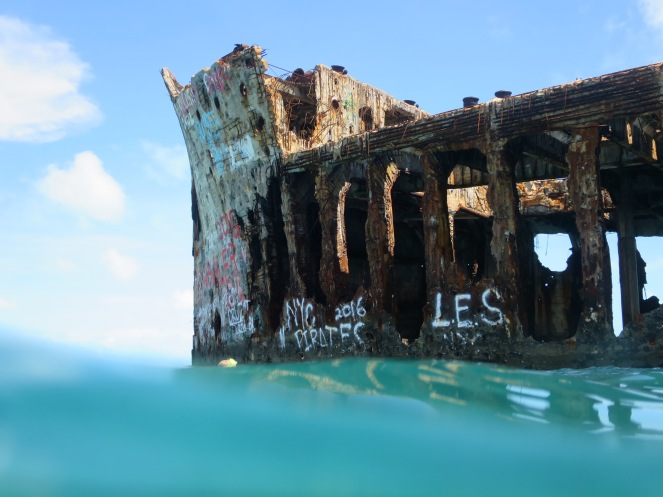Bimini is an island of shipwrecks. Some intentionally abandoned, others cast away and run aground by the force of hurricanes. Four miles south of Bimini, a ghostly structure sits fixed on the horizon, halfway between the big game capital and the palmed private island of Cat Cay. The rusted red hull of the S.S. Sapona starkly contrasts the cerulean blue water that Bimini is known for. Its concrete carcass has been bombarded by the elements. Used for target practice by the U.S. Navy and Air Force during World War II, and battered by hurricanes that have ripped and submerged her stern, the historic wreck is spending her afterlife as a popular dive site.
Anchoring just off the Sapona’s bow, graffiti tags are emblazoned on her hull with “NYC Pirates 2016” scrawled prominently in white paint. Mementos scrawled by wreck-jumpers who wanted to leave their mark on this iconic wreck. I’m more interested in what lies beneath the crystal blue waters. Shaped by salt water, and pockmarked with holes, the concrete hull provides refuge for hundreds of species of tropical fish.
Sliding into the water, the visibility is high. In 15 feet of water, the Sapona is a shallow wreck to free dive. Entering through a gash in the bow, the interior of the wreck is a grotto of rusted ruins and orange cup corals. Hidden in the ship’s crevices are large spiny lobsters and ocher colored sea stars. Queen trigger fish and grunts swim leisurely past divers, unconcerned by their presence. Looking up from beneath the depths I’m struck by the quiet. Fractured sunlight filters through holes overhead, lighting up the watery ruins below. Swimming between the corroded pillars of the hull, a queen trigger circles. Its undulating fins moving like little wavelets through the water column. Its scales are a kaleidoscope of colors. Yellow at the throat, purple, turquoise, and green hues distinguish this trigger from the rest. Swimming past my mask, I notice the intricate striated blue lines on its head and fins.
While the Sapona is a famed wreck to dive in the Bahamas, its eccentric back story is less well known.
During WWI, steel became an extremely rare commodity. So much so that warships began to be reinforced with concrete. Originally commissioned by Woodrow Wilson in 1920 as part of the Emergency Fleet Program, the Sapona was one of twenty-four intended concrete vessels to serve in the war effort. Shortly after its launch, the war ended and the Sapona was repurposed to serve as a barge. The extravagant 20s brought the Sapona new ownership. During Prohibition, a prominent South-Beach developer, Carl Fisher, purchased the Sapona with dreams of converting the cargo ship into a private, floating speakeasy in Miami. However, this pipe-dream never materialized and the Sapona was sold once again as a cargo ship, but this time to a rum-running captain named Bruce Bethel. Bethel took the Sapona to Bahamian waters to transport the precious cargo between the islands and the Eastern United States. With similar dreams as Fisher, Bethel intended to convert the Sapona to a floating night club and liquor warehouse. Before Bethel’s dream could materialize, a devastating hurricane swept through the Bahamas. En route to Florida, the 270-foot Sapona was no match for the 150+ winds of the 1926 hurricane. The rough seas thrust her atop the reef, ripping her stern off in the process. With his precious cargo lost to the crystalline seas, Bethel never recovered financially. The Sapona began her transition from infamous rum running cargo ship to famed wreck. The United States Army and Air Force aided in her decay by using her for target practice during the onset of WWII. Once again a figment of military history, fighter planes and bombers began to pelt the ship day after day with 50mm machine gun fire.
Today, she remains in the same watery grave atop a reef, keeping dominion over the horizon. For fisherman and dive tour operators, the Sapona is a popular waypoint. A well known dive spot, the Sapona even attracted the attention of James Bond author Ian Fleming, with the ship becoming a fictional hiding place for two atomic bombs in the book Thunderball.
Teeming with marine life, the Sapona acts as a sanctuary for hundreds of tropical fish, and a useful substrate for corals to grow.


